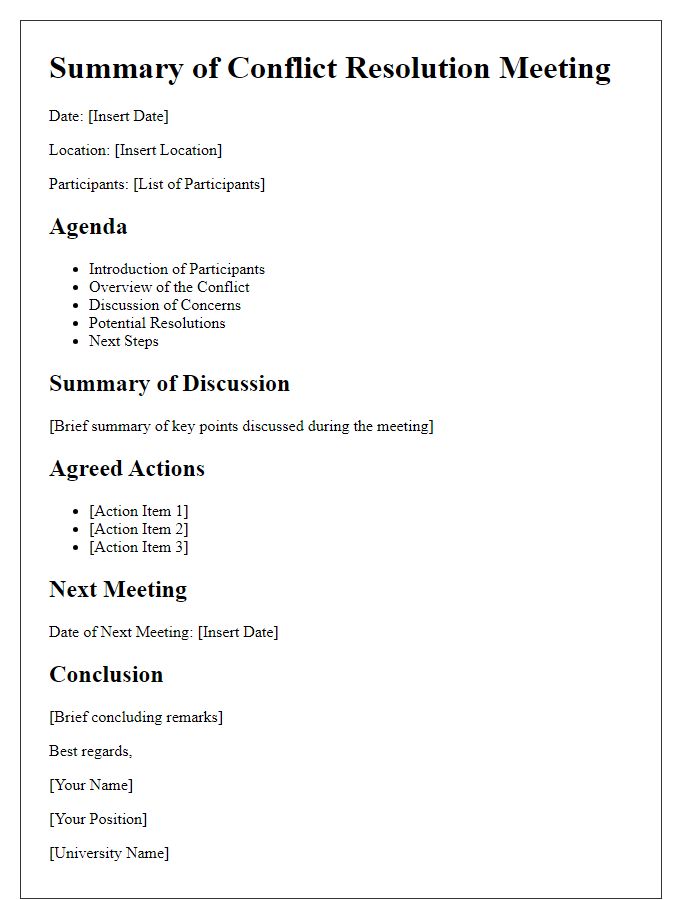Navigating conflicts in a university setting can be daunting, but effective communication is key to finding a resolution. Whether it's a dispute with a professor or issues with fellow students, addressing these concerns head-on not only fosters understanding but also promotes a collaborative learning environment. In this article, we'll explore practical letter templates that can help articulate your thoughts clearly and respectfully during conflict resolution meetings. Ready to learn how to express your concerns effectively? Let's dive in!

Clear identification of parties involved
In a university conflict resolution meeting, clear identification of parties involved is crucial for effective dialogue. The primary parties often include the disputant students, representing conflicting perspectives, and the university's conflict resolution officer, who facilitates the process. Additional parties might involve faculty members relevant to the issue or an adviser who provides support to the students. Each party's role must be defined, including their stake in the conflict, such as academic integrity disputes or interpersonal conflicts impacting campus life. This comprehensive identification streamlines communication and promotes a resolution focused on mutual understanding and collaboration.
Concise description of conflict
A recent conflict arose between students in the Environmental Science department at Greenfield University regarding project responsibilities for the upcoming sustainability initiative. Student A claims that Student B consistently disregards agreed-upon tasks, leading to an unequal workload distribution. Tensions escalated during group meetings, where communication issues surfaced, resulting in personal disputes and a more significant divide within the team. A mediator is needed to address these concerns, facilitate constructive dialogue, and restore collaboration among team members before the project deadline on November 15, 2023.
Proposed resolution approach
The proposed resolution approach for university conflict resolution meetings emphasizes mediation as a first step to address disputes. Mediation involves an impartial third party facilitating discussion between involved parties to promote understanding and compromise. Specific steps include identifying the conflict's root causes, gathering perspectives from both sides, and exploring potential solutions collaboratively. A timeline for resolution should be established, ideally within two weeks from the initial meeting, ensuring timely resolution. Documentation of agreements reached, such as action items and responsibilities, should be shared with both parties to foster accountability. Follow-up meetings may be scheduled to revisit the agreement's effectiveness and make adjustments as necessary, promoting long-term harmony within the university community.
Schedule details for the meeting
A university conflict resolution meeting can involve various stakeholders, including students, faculty, and administrative staff. The meeting often occurs at the university's conference room (like Room 210 in the Student Services Building) on a designated date, such as October 25th, 2023, at 2 PM. The agenda may include discussing specific issues related to academic integrity, housing disputes, or interpersonal conflicts. It is important to prepare necessary documentation, such as relevant emails or reports, to substantiate claims or concerns raised during the meeting. Attendees may also be advised to review the university's code of conduct prior to the meeting to ensure an informed dialogue. The presence of a neutral arbitrator, such as a faculty member trained in conflict resolution, can also facilitate productive discussions among the parties involved.
Contact information for follow-up
During a university conflict resolution meeting, providing accurate contact information is vital for effective follow-up. Essential details include the full name of the involved parties, such as students or faculty members, email addresses (for instance, studentID@university.edu), and phone numbers, which may include area codes. Additionally, specify the date of the meeting held in September 2023, the location (e.g., Room 101, Administration Building), and names of attending mediators or committee members. Also include the agenda topics discussed, ensuring all parties have clarity on resolutions and next steps. This information fosters accountability and encourages ongoing communication to address any lingering issues.
Letter Template For University Conflict Resolution Meeting Samples
Letter template of notification for upcoming university conflict resolution meeting

Letter template of confirmation for university conflict resolution meeting attendance

Letter template of follow-up after university conflict resolution meeting

Letter template of feedback request for university conflict resolution meeting

Letter template of appeal for university conflict resolution meeting outcome

Letter template of introduction for university conflict resolution meeting participants








Comments